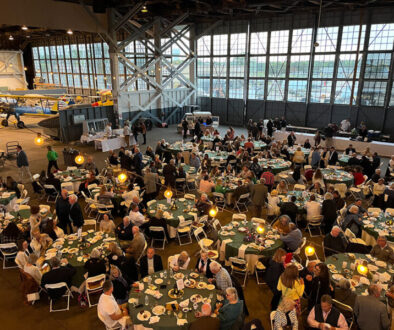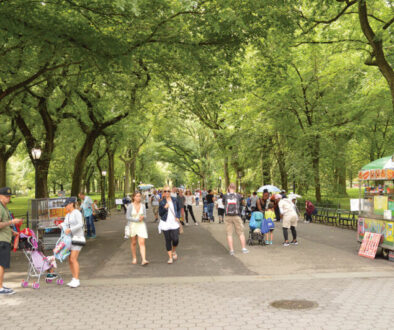Interior Motives
Making it Modern Farmhouse
Katie Rementer is something of an expert at farmhouse design style. The one-woman show behind Cedar Mill Lane, Rementer got her start in the interior design business by way of painted furniture, a staple of farmhouse style. “There has been a transition,” Rementer says. “When I started out doing furniture, I would take the completed piece, stage it, and take photos. I have a friend who’s a realtor in Cape May, and she took notice of how I staged the items and one day just asked me, ‘Hey can you just come in and do that but to an entire room?’”
Rementer jumped at the chance, and before long, she was taking on projects like entire 3500-square-foot houses.
“It kind of became the primary focus of my business,” says Rementer of the interior design side.
And although Rementer challenges herself to work with different design styles, her clients dictate their preferences. And those preferences often include farmhouse style design.
“Farmhouse is so popular, it’s definitely one of my top requested looks,”says Rementer. “So, I guess as far as what you’d consider my expertise, it would probably be farmhouse, just because that’s what I’m usually presented with.”
It’s no wonder. The style is ubiquitous and seems to be just as crowd-pleasing in the mountains of Vermont and the hills of Texas as it is in our local island towns. Popularized by Chip and Joanna Gaines of HGTV fame, modern farmhouse has been around for a while, but with comfort and coziness at the heart of it, it’s a style that doesn’t seem to be going anywhere.
As a furniture painter, Rementer is a fan of the farmhouse style; however, she personally leans more towards antique as opposed to modern farmhouse. The difference? Rementer says that the former is a little more curated, consisting of mostly antique pieces with a story, while modern farmhouse is a bit cleaner cut.
“In a way, modern farmhouse is kind of easier to attain,” says Rementer. “Modern farmhouse is going to have more contemporary, new furniture mixed with some old stuff that’s painted, but usually a lot of contemporary items in it. I’m thinking TJ Maxx and Hobby Lobby. If you look in the right places, even if it’s not something you might label as farmhouse, it can find the right place in your farmhouse—West Elm rugs, Pottery Barn, even Wayfair.”

What does Modern Farmhouse Style look and feel like?
“When it comes to modern farmhouse, what comes to mind for me is a lot of white, very clean—not sterile, but clean—kind of billowy, neutral tones with some light, probably pastel accents,” says Rementer. “I’m thinking gray cabinets, maybe a gray butcher block island.”
The thing about this style—modern included—is that it evokes comfort. And that there’s a ton of freedom involved. “The one thing I notice when I do farmhouse versus, say, a mid-century modern room, is that you have so much freedom with whatever material you want to use. And again, that’s a huge allure for the style,” says Rementer. “For example, with lighting, you can go with a natural rattan light fixture, you can go with metal, you can go with fabric shaded—I’ve seen people use Capiz-shell lighting—tastefully. As long as it fits the mood of the room, you can pretty much get away with anything when it comes to farmhouse. You can explore these corners of your taste.”
That flexibility is apparent, too, in many of the furniture choices in modern farmhouse design.
“You have people that go heavily one way or the other,” says Rementer, on including new and old furniture in design. “There are those that don’t want a single used item in their whole house and it’s all brand new, and then you have some that really want to mix a little bit of both—I probably fit in there myself. I have a brand-new sofa and brand-new armchairs, but the lines are similar to something you might find at an antique shop. And then you have those who go hard with the antique look.”
And while the result is relaxed, and the flexibility makes it seem like there’s an “anything goes” type of mentality associated with modern farmhouse style, that’s hardly the case. That comforting, lived-in feeling is actually the result of a well-executed plan, one that considers scale, color, fabric, and vignetting.
“I call it cultured layering,” says Rementer, of what other people might call clutter. “Farmhouse is probably one of the most appropriate environments to have this vignetting of certain pieces, creating a focal point in any given area. So rather than having this equal disbursement of stuff throughout the room, I’ll focus on key areas to craft this landscape—a tablescape, a bedscape—creating this balanced display on a piece (like) a chair, a bed, a dining table. A coffee table is one most people would recognize. Unstructured layering is one of the best things you can do for yourself. When I do a client’s bedspread, I have quilts layered on top of each other. I love to use blankets and pillows to balance what could be considered an off-centered room. It’s more storytelling versus something that’s a little more poised.”
Despite the care that goes into the design, Rementer is just as clear about what modern farmhouse style is not. “We’re not creating a showroom, or a furniture store display,” she says. “And we want to stick with stuff that isn’t overwhelming to the eye. It’s comforting and cozy, and it’s welcoming, and there’s nothing there that’s going to assault any of your senses. You don’t want something that’s intimidating that you don’t want to go near.”
Likewise, it’s not “country.” “A lot of people don’t really realize there can be a big difference between farmhouse and country,” says Rementer. “They are two very different styles, as similar as they sound.” Rather, it’s the implementation of key elements that lend themselves to a fresh, clean, airy space. Rementer suggests adding some natural elements like a jute rug to soften the edges of a room. Likewise, a slipcover can help create that unstructured, uncoiffed vibe that is so central to modern farmhouse style.
“As for color palette, whites, neutrals, earth tones, lots of wood,” says Rementer. “A perfect formula for ‘modern farmhouse in one day’ is white, wood, and greenery. It’s almost always going to give you the desired outcome. Maybe some antique blue glass and real-life greenery, or earth tones like beiges, greys, browns, and greens.”
The best part? It’s (kind of) easy to do.
“If you’re mixing a lot of neutrals with some light patterning in them that aren’t competing with one another too much, you’re going to have a farmhouse room before you know it,” says Rementer. “It’s fairly easy to achieve.”
In many ways, it’s also very practical. While whites and lights may be off limits for the fabric furniture in your home, there are materials that fit the modern farmhouse aesthetic that are known for their functionality, particularly duck canvas, a type of heavily woven fabric that was traditionally used for portions of sailors’ uniforms.
“It’s a more robust fabric. It’s tough, comes in really nice clean colors and patterns and is pretty versatile. If I do upholster something for a client, it’s almost always what I use,” says Rementer. “It’s easy to wash and it looks great after it’s been washed. That’s a huge pull for farmhouse looks in general. It’s unstructured, doesn’t have to be perfectly coiffed and pressed and wrinkleless. It can look lived in and still look good.”
In addition to Rementer’s tips on color and feel, possibly her most important tip is to include what you love.
“I’m not a good authority to consult with on practicality. I’m a firm believer that life is too short to be practical. If it makes you happy, buy the white sofa,” says Rementer—who has two kids, one dog, and a very white couch. “If there’s a piece that you keep coming back to in your head, that you can’t stop thinking about, that means your house needs it. I always recommend you go get that piece. Even if you don’t know where you’re going to put it right away—go get it!” ■



